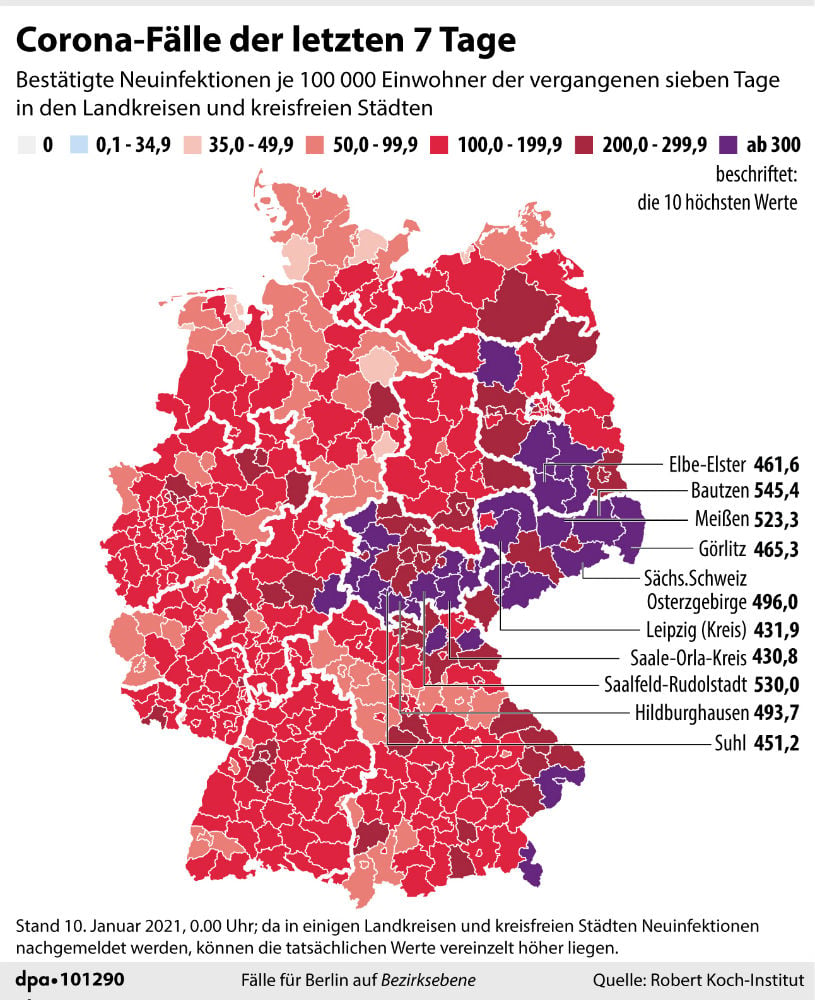15 km rule: Which areas in Germany are affected by new movement restrictions?

People living in badly-hit coronavirus areas in Germany are now subject to new movement rules. Here are the areas affected and how to calculate the 15 kilometre radius.
What is the 15 km rule?
Chancellor Angela Merkel and state leaders decided last week on new tighter rules to try and stem the spread of Covid-19 to bring numbers down and ease the burden on hospitals.
As part of the new measures people living in districts with very high Covid infection rates will have their freedom of movement drastically restricted.
For districts with a 7-day incidence of more than 200 new infections per 100,000 residents, the radius of movement is to be restricted to a 15 km radius around the area you live, unless there is a valid reason to travel further.
Exceptions can include trips for work or medical appointments.
"Shopping, travelling and day-trips explicitly do not constitute a valid reason," the government and states say.
Chancellor Merkel had been pushing for this order to come into force in regions with an incidence rate of 100 infections per 100,000 people in seven days. If Merkel had got her way, this rule would have applied to most of the country, effectively bringing travel to a complete standstill.
The travel restriction can be lifted if the infection levels are below 200 for a period of time (usually at least seven consecutive days). Note that not every state is enforcing the rule, and there can be differences in the way it is rolled out.
READ ALSO: These are Germany's new tighter lockdown rules
These are the areas with an incidence over 200 as of Monday January 11th
Bavaria
District of Passau
Berchtesgadener Land district
Wunsiedel district
Kulmbach district
Coburg
Passau
Deggendorf district
District of Coburg
District of Kronach
District of Rottal-Inn
District of Bayreuth
District of Regen
District of Roth
Landshut
District of Donau-Ries
District of Cham
Hof
District of Tirschenreuth
Fürth
Lichtenfels district
District of Weißenburg-Gunzenhausen
Miesbach
Weiden i.d.Opf
District of Freyung-Grafenau
Rosenheim
Ingolstadt
District of Dingolfing-Landau
Haßberge district
The map below gives an idea of the worst affected areas in Germany as of January 11th. The deep red and purple coloured areas have over 200 cases per 100,000 residents in seven days and may be affected by new restrictions.

Brandenburg
District of Dahme-Spreewald
District of Elbe-Elster
Frankfurt Oder
District of Oder-Spree
District of Oberspreewald-Lausitz
District of Ostprignitz-Ruppin
District of Potsdam-Mittelmark
District of Teltow-Fläming
District of Uckermark
Havelland district
Spree-Neisse district
Cottbus district
Hesse
Gießen
Limburg-Weilburg district
Vogelsbergkreis
District of Fulda
Mecklenburg-Western Pomerania
Mecklenburg Lake District
Lower Saxony
District of Gifhorn
Lower Saxony does not force affected districts to apply the 15 km rule, but leaves it up to the municipalities.
Saarland
District of Saarbrücken
Saxony
District of Meißen
District of Bautzen
District of North Saxony
District of Sächsische Schweiz-Osterzgebirge
District of Erzgebirgskreis
Görlitz district
Central Saxony district
Leipzig
Zwickau district
Chemnitz
Vogtlandkreis district
Dresden
Saxony-Anhalt
Anhalt-Bitterfeld
District of Dessau-Roßlau
Halle
Wittenberg district
Saalekreis district
Burgenlandkreis
Schleswig-Holstein
No district above 200 incidence yet
Rhineland-Palatinate
Worms
Ludwigshafen am Rhein
District of Bad Kreuznach
Thuringia
Saalfeld-Rudolstadt district
District of Hildburghausen
Suhl
Eichsfeld district
District of Schmalkalden-Meiningen
District of Saale-Orla
Unstrut-Hainich district
District of Altenbuger Land
Wartburkreis district
Sonneberg district
Hildburghausen District
Saale-Holzland district
Gotha district
Saale-Holzland district
Greiz district
Eisenach district
Sömmerda district
Ilm district
Kyffhäuserkreis
Nordhausen district
District of Gera
Jena district
District of Weimarer Land
District of Erfurt
In Thuringia, the radius of movement will not be restricted by decree. The cabinet agreed on a recommendation, not an obligation.
Berlin
The new rule kicks in on Saturday January 16th. Read more in our story here.
North Rhine-Westphalia
Since Tuesday January 12th, the 15 km rule has also been in force in NRW.
The state government issued a regional ordinance with specifications on how and in which districts people's radius of movement will be restricted. The ordinance initially lists four districts: Höxter, Minden-Lübbecke, Recklinghausen and the Oberbergischer Kreis.
Hamburg
No areas of over 200 incidence reported so far.
The 15-kilometre rule does not apply in these federal states at the moment:
Baden-Württemberg
Bremen
However, the situation can change quickly so keep an eye on your local rules (and the incidence number in your district). You'll find information on the Robert Koch Institute website.
READ ALSO:
-
Schools, contact rules and travel: What you need to know about Berlin's new Covid-19 restrictions
-
This is how Germany's coronavirus rules vary between states
How do you calculate a 15 km radius?
The aim is to stop people from going on day trips. The German government and states already say that in general everyone should refrain from non-essential travel, whether it's within the country or abroad.
So it's safe to say wherever you live, authorities would prefer if you didn't travel far.
If you need to calculate a 15 km radius there are a few sites where you can do that.
Note that the place of residence is usually the city/town where you live, not your own address. But in some states the rules may differ on what is classed as your place of residence.
To work out the radius, you could try the CalcMaps calculator here.
You could also try this interactive calculator.
Please keep in mind that this article, as with all of our guides, are to provide assistance only. They are not intended to take the place of official legal advice.
Comments
See Also
What is the 15 km rule?
Chancellor Angela Merkel and state leaders decided last week on new tighter rules to try and stem the spread of Covid-19 to bring numbers down and ease the burden on hospitals.
As part of the new measures people living in districts with very high Covid infection rates will have their freedom of movement drastically restricted.
For districts with a 7-day incidence of more than 200 new infections per 100,000 residents, the radius of movement is to be restricted to a 15 km radius around the area you live, unless there is a valid reason to travel further.
Exceptions can include trips for work or medical appointments.
"Shopping, travelling and day-trips explicitly do not constitute a valid reason," the government and states say.
Chancellor Merkel had been pushing for this order to come into force in regions with an incidence rate of 100 infections per 100,000 people in seven days. If Merkel had got her way, this rule would have applied to most of the country, effectively bringing travel to a complete standstill.
The travel restriction can be lifted if the infection levels are below 200 for a period of time (usually at least seven consecutive days). Note that not every state is enforcing the rule, and there can be differences in the way it is rolled out.
READ ALSO: These are Germany's new tighter lockdown rules
These are the areas with an incidence over 200 as of Monday January 11th
Bavaria
District of Passau
Berchtesgadener Land district
Wunsiedel district
Kulmbach district
Coburg
Passau
Deggendorf district
District of Coburg
District of Kronach
District of Rottal-Inn
District of Bayreuth
District of Regen
District of Roth
Landshut
District of Donau-Ries
District of Cham
Hof
District of Tirschenreuth
Fürth
Lichtenfels district
District of Weißenburg-Gunzenhausen
Miesbach
Weiden i.d.Opf
District of Freyung-Grafenau
Rosenheim
Ingolstadt
District of Dingolfing-Landau
Haßberge district
The map below gives an idea of the worst affected areas in Germany as of January 11th. The deep red and purple coloured areas have over 200 cases per 100,000 residents in seven days and may be affected by new restrictions.

Brandenburg
District of Dahme-Spreewald
District of Elbe-Elster
Frankfurt Oder
District of Oder-Spree
District of Oberspreewald-Lausitz
District of Ostprignitz-Ruppin
District of Potsdam-Mittelmark
District of Teltow-Fläming
District of Uckermark
Havelland district
Spree-Neisse district
Cottbus district
Hesse
Gießen
Limburg-Weilburg district
Vogelsbergkreis
District of Fulda
Mecklenburg-Western Pomerania
Mecklenburg Lake District
Lower Saxony
District of Gifhorn
Lower Saxony does not force affected districts to apply the 15 km rule, but leaves it up to the municipalities.
Saarland
District of Saarbrücken
Saxony
District of Meißen
District of Bautzen
District of North Saxony
District of Sächsische Schweiz-Osterzgebirge
District of Erzgebirgskreis
Görlitz district
Central Saxony district
Leipzig
Zwickau district
Chemnitz
Vogtlandkreis district
Dresden
Saxony-Anhalt
Anhalt-Bitterfeld
District of Dessau-Roßlau
Halle
Wittenberg district
Saalekreis district
Burgenlandkreis
Schleswig-Holstein
No district above 200 incidence yet
Rhineland-Palatinate
Worms
Ludwigshafen am Rhein
District of Bad Kreuznach
Thuringia
Saalfeld-Rudolstadt district
District of Hildburghausen
Suhl
Eichsfeld district
District of Schmalkalden-Meiningen
District of Saale-Orla
Unstrut-Hainich district
District of Altenbuger Land
Wartburkreis district
Sonneberg district
Hildburghausen District
Saale-Holzland district
Gotha district
Saale-Holzland district
Greiz district
Eisenach district
Sömmerda district
Ilm district
Kyffhäuserkreis
Nordhausen district
District of Gera
Jena district
District of Weimarer Land
District of Erfurt
In Thuringia, the radius of movement will not be restricted by decree. The cabinet agreed on a recommendation, not an obligation.
Berlin
The new rule kicks in on Saturday January 16th. Read more in our story here.
North Rhine-Westphalia
Since Tuesday January 12th, the 15 km rule has also been in force in NRW.
The state government issued a regional ordinance with specifications on how and in which districts people's radius of movement will be restricted. The ordinance initially lists four districts: Höxter, Minden-Lübbecke, Recklinghausen and the Oberbergischer Kreis.
Hamburg
No areas of over 200 incidence reported so far.
The 15-kilometre rule does not apply in these federal states at the moment:
Baden-Württemberg
Bremen
However, the situation can change quickly so keep an eye on your local rules (and the incidence number in your district). You'll find information on the Robert Koch Institute website.
READ ALSO:
- Schools, contact rules and travel: What you need to know about Berlin's new Covid-19 restrictions
- This is how Germany's coronavirus rules vary between states
How do you calculate a 15 km radius?
The aim is to stop people from going on day trips. The German government and states already say that in general everyone should refrain from non-essential travel, whether it's within the country or abroad.
So it's safe to say wherever you live, authorities would prefer if you didn't travel far.
If you need to calculate a 15 km radius there are a few sites where you can do that.
Note that the place of residence is usually the city/town where you live, not your own address. But in some states the rules may differ on what is classed as your place of residence.
To work out the radius, you could try the CalcMaps calculator here.
You could also try this interactive calculator.
Please keep in mind that this article, as with all of our guides, are to provide assistance only. They are not intended to take the place of official legal advice.
Join the conversation in our comments section below. Share your own views and experience and if you have a question or suggestion for our journalists then email us at [email protected].
Please keep comments civil, constructive and on topic – and make sure to read our terms of use before getting involved.
Please log in here to leave a comment.